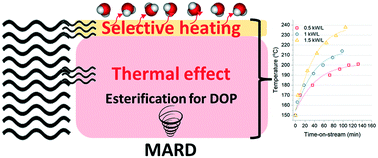Breaking the equilibrium at the interface: microwave-assisted reactive distillation (MARD)†
Abstract
Microwave irradiation has shown an intensification effect on reactive distillation. Herein, we report a systematic study of microwave-assisted reactive distillation (MARD) relative to its counterpart by conventional heating, aiming at understanding the intensification mechanism of MARD. Catalytic homogeneous esterification of phthalic anhydride with 2-ethylhexanol for producing dioctyl phthalate (DOP) was studied as the model system, showing the improved performance of MARD in comparison with the system by the conventional heating. However, a comparative study on the effect of the reaction temperature and microwave power density showed that the reaction system was mainly affected by the system temperature, suggesting a dominant thermal effect in MARD. The phase equilibrium of the model system for the different heating methods was investigated, showing an improved water content in the vapour phase promoted by the microwave heating compared to that by the conventional heating. Therefore, the rapid selective heating of the water content at the liquid–vapour interface in MARD caused a change of the relative volatility of the system, facilitating the intensified evaporation of water molecules at the liquid–vapour interface and hence the improved performance.

- This article is part of the themed collection: 2019 Reaction Engineering in China


 Please wait while we load your content...
Please wait while we load your content...